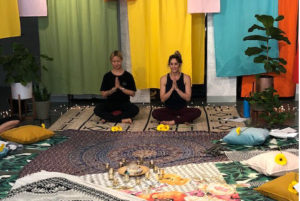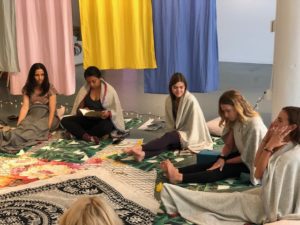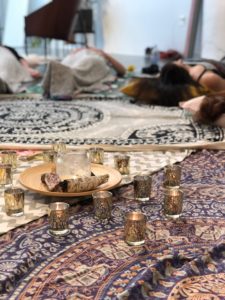Time to talk triggers! Oh, the dreaded “t” word. At some point in our lives we will all have them, no one is immune. Even Oprah has them – so you’re in good company.

Setting an intention with Mel Mah to get clear about our triggers.
But what is a trigger? A trigger is an external event, situation, person or activity that sparks an emotional or physical reaction within us. Something happens and a wound, memory or experience re-opens and in that raw and exposed moment you feel A LOT. Often times we connect triggers to feeling of discomfort or dis-ease. But the truth is, there are just as many triggers that bring us a sense of joy, ease, safety and comfort as there are one that make us feel anxious or all “hot and bothered”.
Because I get a lot of asks around how to better manage aggravating triggers (as I like to call them), I will focus this blog on how we can explore these a little deeper.
Aggravating triggers are ones that can do just that— aggravate. This can show up in pain, sadness, increased stress, frustration and my big one, anxiety. And it’s not just the symptom or feeling that can throw off our day or week, but our response to to the trigger can greatly effect our life.
For example, have you ever gotten into a confrontation with a co-worker, friend, loved one, or even stranger on the road because you were triggered? Do you remember how that effected your day? Boy, I know I have and it’s always ended with me feeling unmotivated, fatigue, and unhappy. Some reactions can even send you down a spiral of doubt, fear, loss, you name it.
And to add fuel to the fire, some of the most common aggravating triggers related to stress, pain, and anxiety are ones we cannot avoid:
- Work – Commuting to work (traffic!!), being at work (sitting…ugh), and having deadlines at work have the potential to trigger our worries, increase our stress and create lots of tension.
- Family – Being around specific family members can make us feel more stressed, frustrated and annoyed than usual.
- Life changes – A change is just experiencing something new, but the uncertainty and lack of routine can make us panic even if it’s something we wanted (like having a baby).
- Social media – I’m throwing this one in because it’s given me some serious anxiety lately! Scrolling through “the ‘gram” and seeing everyone living their best life can trigger all sorts of comparisons, fear of missing out, lack of confidence, you name it.
At the core, a trigger is a habit. There is cause – your mom calls, your boss sends a rude email, you’re stuck in traffic – and at some point you learned or trained yourself over time to react to that fear – you panic, you get defensive, you scream, you shut down. Your reaction was initially part of your neurological “flight or fight” response to keep you safe, but is now a pattern (a likely old pattern) you are used to doing as a way to survive and protect yourself.

Workshop attendees getting deep into what’s underneath their triggers.
We all have triggers because life is filled with ups and downs and eventually we all experience some sort of trauma or challenge. That could be the emotional trauma of losing a loved one, being bullied, witnessing your parents fight or any time you have been made to feel that you’re not enough.
The good news is that since triggers are habits learned over time, we can unlearn them too! The bad news is that they are some of the hardest habits to break because many are embedded in how we see the world and ourselves.
Let’s look at an example. One of my biggest aggravating triggers is having a messy house, which triggers feelings of panic, anxiety, and a loss of control. It dates back to growing up in a chaotic house with lots of noise and fighting. So whenever my home is messy – looks chaotic and even feels chaotic – I’m taken back to that feeling of being a little girl who doesn’t feel safe and that makes the grown woman version of me feel unsafe too.
You might be thinking, “of course a messy home elicits some sort of reaction.” But I’m pretty sure that around the world, millions of people have messy homes and don’t launch into a state of panic and extreme unease. Now what’s interesting about this trigger, is that it’s very specific to my home. I don’t feel panicked when my friend’s home is messy or a department store is messy.
Over the years I’ve done a lot of work on this one, so I am definitely more forgiving when things aren’t “perfect” and because I share a home with someone else (my husband), I try hard to not nit pick and get overworked (stay tuned for another blog on working through your triggers). But the first step to even working through those unresolved feelings is to “notice” what your triggers are. This requires a little mindfulness and a lot of curiosity.
Here are 3 easy and eye-opening steps to get you started: Stop, Breathe, Feel. Disclaimer: You likely have dozens of aggravating triggers, but let’s just focus on spotting one.
1. Stop and observe the external: The very next time you feel the pit in your stomach, worried feelings, racing heart, achey back – stop and pay attention. You don’t have to do this immediately, but within the day take stock of your external circumstances. Perhaps, there was an external event that happened right before your feelings began.
What are you doing? Who are you with? What’s going on around you? Notice all of the details of your environment, your trigger is lurking in one of those areas. If you were talking to someone, what did they say to you? Get out a piece of paper or your phone and write down the details for later.

Meditation helps you practice breathing and uncover the layers of feelings.
2. Breathe to capture the moment: Very important step. You need to breathe so you can slow yourself down and get curious about the event. If you have a meditation practice, use that to meditate for at least 5 minutes. If not, try a 5-4-5 breath to help you focus – Inhale for 5 counts, hold for 4 counts, and exhale for 5 counts. Repeat this at least 3X to ensure you are clear enough to proceed to the next step.
3. Feel what’s going on internally: What exactly are you feeling? Yes, bothered of course, but what specifically? Are you feeling bad about a conversation that didn’t go as expected and now you’re worried that you’ll get in trouble at work? Get curious and detailed about each feeling and micro-feeling that is going on at that moment and the story you’re telling yourself about those feelings. Once you’ve figured this out, map back to the items from Step #1 and start making the connection.
Give this exercise a try a few times and see what you learn about yourself and what’s triggering you. Remember, when noticing triggers it’s important to observe and remain curious about both those that aggravate and those that bring ease. This type of mindful observation can lead to some really clear answers around who we are and also invite in a deeper sense of self-acceptance and self-compassion. Comment and let us know what you discover!


Recent Comments